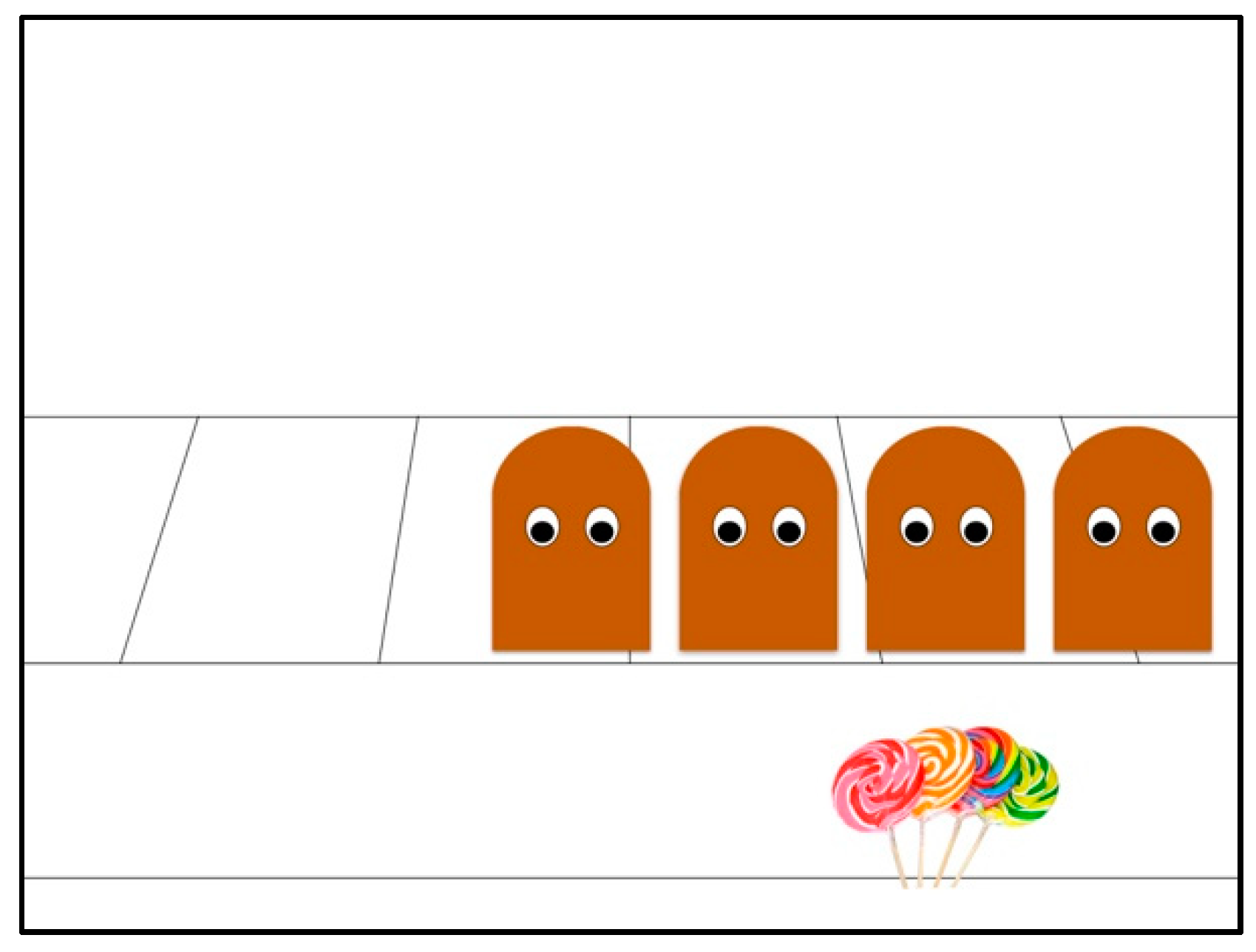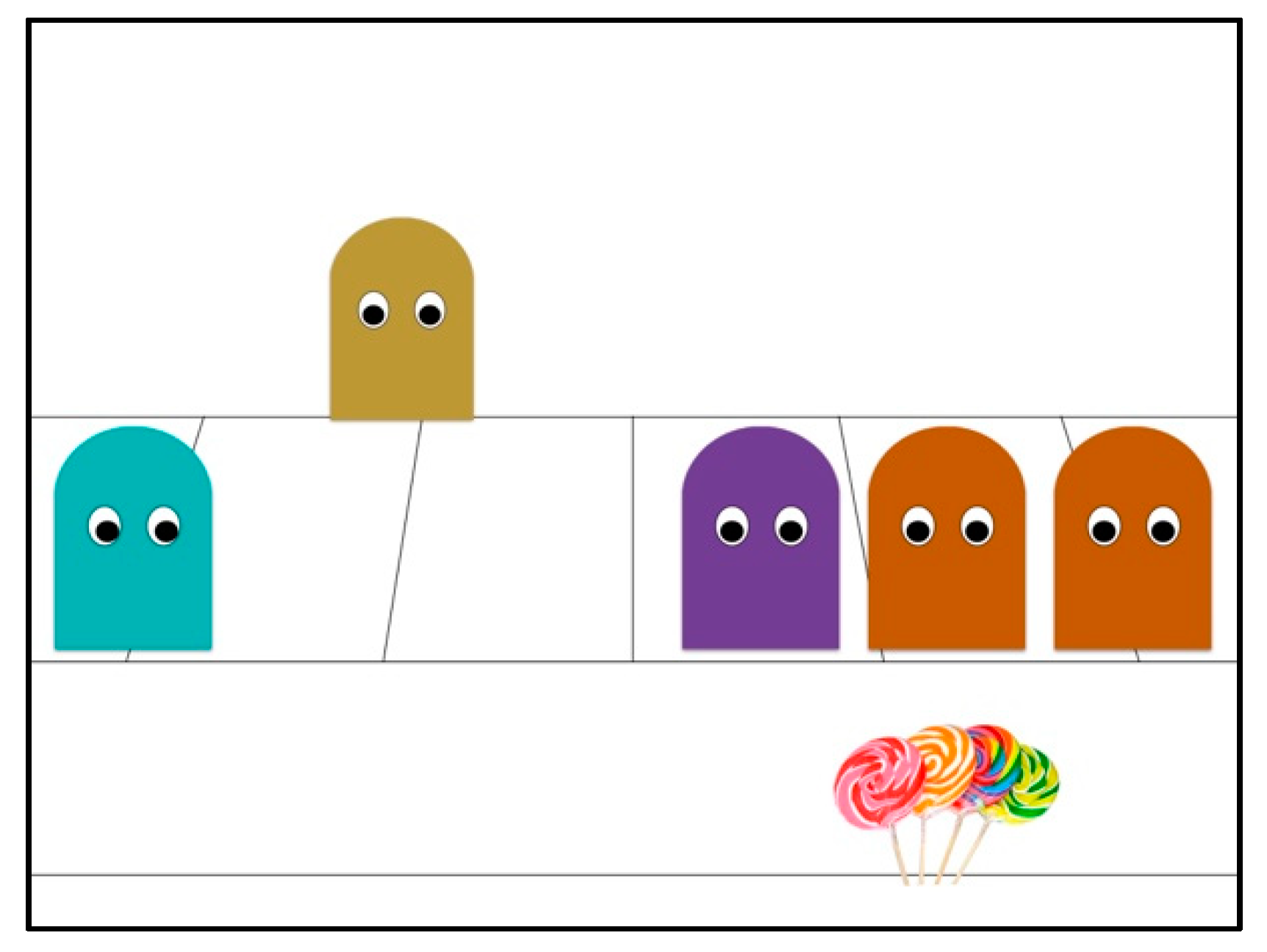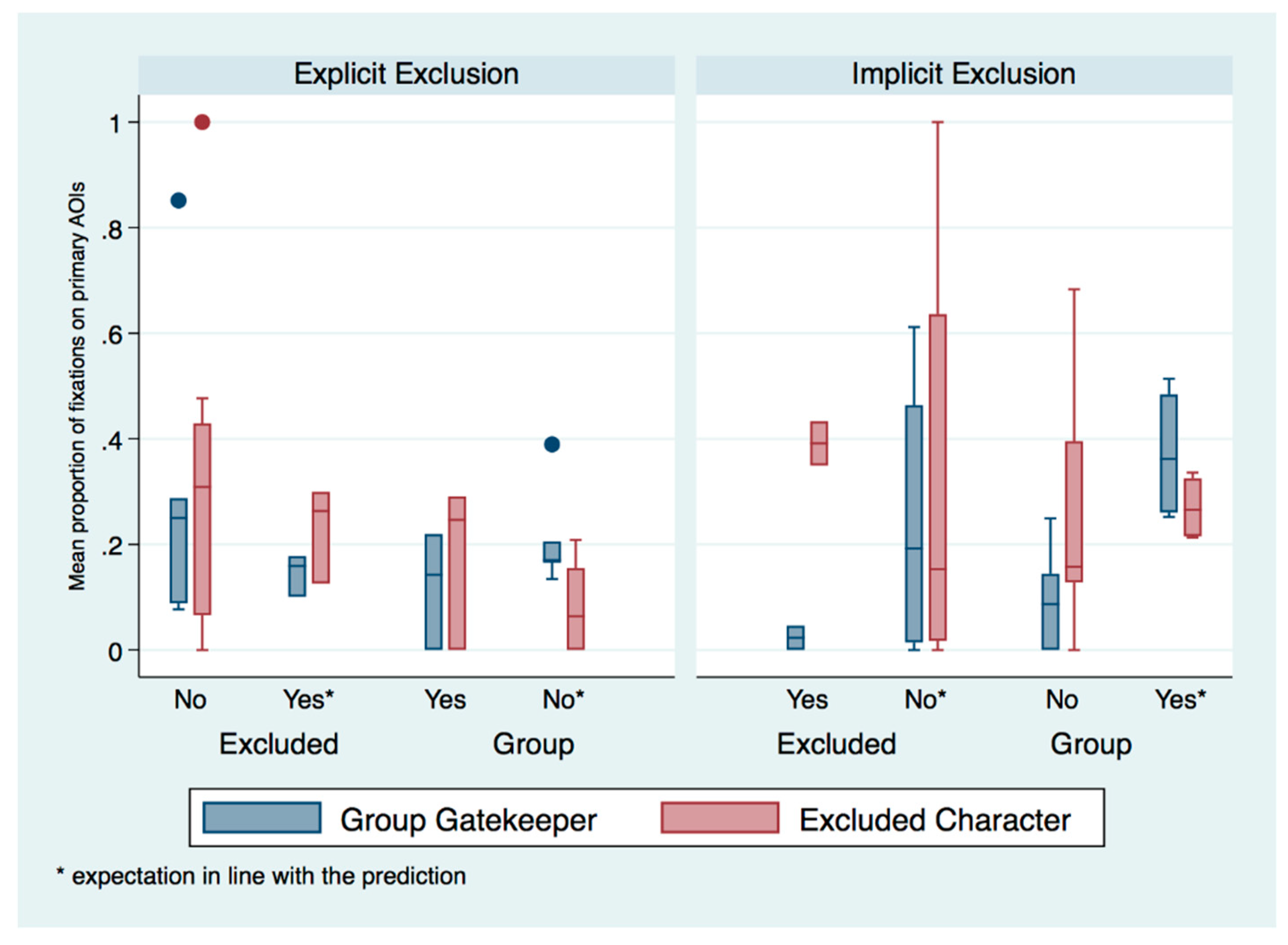Infant Understanding of Different Forms of Social Exclusion
Abstract
:1. Introduction
2. Experiment 1
2.1. Method
2.1.1. Participants
2.1.2. Apparatus and Stimuli
2.1.3. Events
2.1.4. Procedure
2.2. Results
2.2.1. The Preferential Reaching Task
2.2.2. Exploratory Analysis of Gaze Data.
Scanpath Analysis and Attentional Synchrony
Proportion of Fixation Durations on AOIs
Transition Matrices & Entropy
2.3. Discussion
3. Experiment 2
3.1. Method
3.1.1. Participants
3.1.2. Apparatus and Stimuli
3.1.3. Events
3.1.4. Procedure
3.2. Results
3.2.1. Anticipatory Looking Paradigm
3.2.2. Violation of Expectation
3.2.3. Exploratory Analysis of Gaze Data
Scanpath and Attentional Synchrony
Proportion of Fixation Durations on AOIs
Transition Matrices & Entropy
3.3. Discussion
4. General Discussion
5. Conclusions
Funding
Acknowledgments
Conflicts of Interest
Statement of Ethics
References
- Baumeister, R.F.; Leary, M.R. The need to belong: Desire for interpersonal attachments as a fundamental human motivation. Psychol. Bull. 1995, 117, 497–529. [Google Scholar] [CrossRef] [PubMed]
- Beekman, J.B.; Stock, M.L.; Marcus, T. Need to Belong, Not Rejection Sensitivity, Moderates Cortisol Response, Self-Reported Stress, and Negative Affect Following Social Exclusion. J. Soc. Psychol 2016, 156, 131–138. [Google Scholar] [CrossRef] [PubMed]
- Smart Richman, L.; Leary, M.R. Reactions to discrimination, stigmatization, ostracism, and other forms of interpersonal rejection: A multimotive model. Psychol. Rev. 2009, 116, 365–383. [Google Scholar] [CrossRef] [PubMed]
- Hawkley, L.C.; Cacioppo, J.T.; Correll, J. Perceived Social Isolation within Personal and Evolutionary Timescales. In The Oxford Handbook of Social Exclusion; Oxford University Press: Oxford, UK, 2013. [Google Scholar]
- Heatherton, T.F. Neuroscience of Self and Self-Regulation. Annu. Rev. Psychol. 2011, 62, 363–390. [Google Scholar] [CrossRef] [PubMed] [Green Version]
- Powers, K.E.; Heatherton, T.F. Characterizing socially avoidant and affiliative responses to social exclusion. Front. Integr. Neurosci. 2012, 6, 46. [Google Scholar] [CrossRef] [PubMed] [Green Version]
- Juvonen, J.; Graham, S. Bullying in Schools: The Power of Bullies and the Plight of Victims. Annu. Rev. Psychol. 2014, 65, 159–185. [Google Scholar] [CrossRef] [PubMed]
- Shaver, P.R.; Mikulincer, M. An overview of adult attachment theory. In Attachment Theory and Research in Clinical Work with Adults; Guilford Press: New York, NY, USA, 2009; pp. 17–45. ISBN 978-1-59385-998-5. [Google Scholar]
- Bowlby, J. Attachment and Loss, Vol. 1: Attachment; Basic Books: New York, NY, USA, 1969. [Google Scholar]
- Ainsworth, M.; Blehar, M.; Waters, E.; Wall, S. Patterns of Attachment: A Psychological Study of the Strange Situation; Erlbaum: Hillsdale, NJ, USA, 1978. [Google Scholar]
- Bowlby, J. Attachment and Loss, Vol. 3: Loss, Sadness and Depression; Basic Books: New York, NY, USA, 1980. [Google Scholar]
- Simpson, J.; Belsky, J. Attachment Theory within a Modern Evolutionary Framework. In Handbook of Attachment, Third Edition: Theory, Research, and Clinical Applications; Cassidy, J., Shaver, P.R., Eds.; The Guilford Press: New York, NY, USA, 2016; pp. 91–116. ISBN 978-1-4625-2529-4. [Google Scholar]
- Rothbart, M.K. Temperament and the development of inhibited approach. Child. Dev. 1988, 59, 1241–1250. [Google Scholar] [CrossRef] [PubMed]
- Rothbart, M. Temperament in childhood: A framework. In Temperament in Childhood; Kohnstamm, G., Bates, J., Rothbart, M., Eds.; John Wiley & Sons: Oxford, UK, 1989; pp. 59–73. ISBN 978-0-471-91692-5. [Google Scholar]
- Powell, L.J.; Spelke, E.S. Third-Party Preferences for Imitators in Preverbal Infants. Open Mind 2018, 2, 61–71. [Google Scholar] [CrossRef]
- Sommer, K.L.; Bernieri, F. Minimizing the Pain and Probability of Rejection: Evidence for Relational Distancing and Proximity Seeking Within Face-to-Face Interactions. Soc. Psychol. Personal. Sci. 2015, 6, 131–139. [Google Scholar] [CrossRef]
- Molden, D.C.; Lucas, G.M.; Gardner, W.L.; Dean, K.; Knowles, M.L. Motivations for prevention or promotion following social exclusion: Being rejected versus being ignored. J. Pers. Soc. Psychol. 2009, 96, 415–431. [Google Scholar] [CrossRef]
- Csibra, G.; Gergely, G. Natural pedagogy as evolutionary adaptation. Philos. Trans. R. Soc. Lond. B. Biol. Sci. 2011, 366, 1149–1157. [Google Scholar] [CrossRef] [PubMed] [Green Version]
- Bonawitz, E.; Shafto, P. Computational models of development, social influences. Curr. Opin. Behav. Sci. 2016, 7, 95–100. [Google Scholar] [CrossRef] [Green Version]
- Shiferaw, B.; Downey, L.; Crewther, D. A review of gaze entropy as a measure of visual scanning efficiency. Neurosci. Biobehav. Rev. 2019, 96, 353–366. [Google Scholar] [CrossRef] [PubMed]
- Duchowski, A.T. Eye Tracking Methodology: Theory and Practice, 3rd ed.; Springer International Publishing: Cham, Switzerland, 2017; ISBN 978-3-319-57881-1. [Google Scholar]
- Krejtz, K.; Duchowski, A.; Szmidt, T.; Krejtz, I.; González Perilli, F.; Pires, A.; Vilaro, A.; Villalobos, N. Gaze Transition Entropy. ACM Trans. Appl. Percept. 2015, 13. [Google Scholar] [CrossRef]
- Prendergast, C.N.; Spelke, E. Infant Understanding of Different Forms of Social Exclusion. Open Science Framework. 2018. Available online: https://osf.io/e4fhz/ (accessed on 15 May 2018).
- Keynote. Available online: https://www.apple.com/lae/keynote/ (accessed on 15 May 2018).
- Squared 5. Squared 5—MPEG Streamclip Video Converter for Mac and Windows. Available online: http://www.squared5.com/ (accessed on 15 May 2018).
- Tobii Technology AB. Tobii Studio. 2007. Available online: https://www.tobii.com/ (accessed on 15 May 2018).
- R Core Team. R: The R Project for Statistical Computing; R Core Team: Vienna, Austria, 2019. [Google Scholar]
- van Renswoude, D.R.; Visser, I. Gazepath: Parse Eye-Tracking Data into Fixations (Version 1.2). Available online: https://CRAN.R-project.org/package=gazepath (accessed on 1 September 2019).
- Blickshift GmbH. Blickshift Analytics, Blickshift; Blickshift GmbH: Stuttgart, Germany, 2018. [Google Scholar]
- Csibra, G.; Gergely, G. Natural pedagogy. Trends Cogn. Sci. (Regul. Ed.) 2009, 13, 148–153. [Google Scholar] [CrossRef] [PubMed]
- Fawcett, C.; Tunçgenç, B. Infants’ use of movement synchrony to infer social affiliation in others. J. Exp. Child Psychol. 2017, 160, 127–136. [Google Scholar] [CrossRef] [PubMed]
- Schmidt, M.F.H.; Sommerville, J.A. Fairness expectations and altruistic sharing in 15-month-old human infants. PLoS ONE 2011, 6, e23223. [Google Scholar] [CrossRef] [PubMed]
- Gredebäck, G.; Johnson, S.; von Hofsten, C. Eye tracking in infancy research. Dev. Neuropsychol. 2010, 35, 1–19. [Google Scholar] [CrossRef] [PubMed]
- Warneken, F.; Tomasello, M. Helping and Cooperation at 14 Months of Age. Infancy 2007, 11, 271–294. [Google Scholar] [CrossRef]
- Hamlin, J.K.; Wynn, K. Young infants prefer prosocial to antisocial others. Cogn. Develop. 2011, 26, 30–39. [Google Scholar] [CrossRef] [Green Version]
- Hamlin, J.K.; Wynn, K.; Bloom, P. 3-month-olds show a negativity bias in their social evaluations. Dev. Sci. 2010, 13, 923–929. [Google Scholar] [CrossRef] [PubMed]
- Woo, B.M.; Steckler, C.M.; Le, D.T.; Hamlin, J.K. Social evaluation of intentional, truly accidental, and negligently accidental helpers and harmers by 10-month-old infants. Cognition 2017, 168, 154–163. [Google Scholar] [CrossRef] [PubMed] [Green Version]
- Belsky, J.; Pluess, M. Beyond diathesis stress: Differential susceptibility to environmental influences. Psychol. Bull. 2009, 135, 885–908. [Google Scholar] [CrossRef] [PubMed]
- Facebook. Available online: https://www.facebook.com/ (accessed on 5 April 2019).





| Character | Condition | n | M | SD | (95% Confidence Interval) |
|---|---|---|---|---|---|
| Excluded Character | Explicit | 4 | 0.321 | 0.022 | (0.274, 0.368) |
| Explicit * | 12 | 0.338 | 0.019 | (0.297, 0.379) | |
| Implicit | 3 | 0.271 | 0.048 | (0.164, 0.376) | |
| Implicit * | 10 | 0.439 | 0.042 | (0.345, 0.532) | |
| Group Gatekeeper | Explicit | 4 | 0.445 | 0.047 | (0.345, 0.545) |
| Explicit * | 12 | 0.351 | 0.032 | (0.281, 0.419) | |
| Implicit | 3 | 0.230 | 0.058 | (0.101, 0.358) | |
| Implicit * | 10 | 0.268 | 0.022 | (0.218, 0.317) |
| Character | Condition | n | M | SD | (95% Confidence Interval) |
|---|---|---|---|---|---|
| Excluded Character | Explicit | 4 | 0.399 | 0.143 | (0.104, 0.693) |
| Explicit * | 12 | 0.493 | 0.033 | (0.425, 0.561) | |
| Implicit | 3 | 0.714 | 0.117 | (0.473, 0.955) | |
| Implicit * | 10 | 0.433 | 0.092 | (0.242, 0.622) | |
| Group Gatekeeper | Explicit | 4 | 0.601 | 0.143 | (0.306, 0.895) |
| Explicit * | 12 | 0.507 | 0.033 | (0.438, 0.574) | |
| Implicit | 3 | 0.286 | 0.117 | (0.044, 0.526) | |
| Implicit * | 10 | 0.567 | 0.092 | (0.377, 0.757) |
| Direction First Looked | Condition | n | M | SD | (95% Confidence Interval) | p |
|---|---|---|---|---|---|---|
| Excluded | Explicit | 12 | 0.056 | 0.127 | (−0.025, 0.136) | 0.002 ** |
| Explicit * | 10 | 0.332 | 0.238 | (0.162, 0.502) | ||
| Group | Explicit * | 10 | 0.414 | 0.301 | (0.223, 0.606) | 0.130 |
| Explicit | 12 | 0.244 | 0.190 | (0.108, 0.380) | ||
| Excluded | Implicit * | 16 | 0.351 | 0.198 | (0.143, 0.559) | 0.001 ** |
| Implicit | 6 | 0.035 | 0.057 | (0.005, 0.066) | ||
| Group | Implicit | 6 | 0.071 | 0.079 | (−0.012, 0.154) | 0.020 ** |
| Implicit * | 16 | 0.404 | 0.328 | (0.230, 0.579) |
| Direction of Neutral Character | Condition | n | M | SD | (95% Confidence Interval) |
|---|---|---|---|---|---|
| Excluded | Explicit | 8 | 11141.13 | 1631.58 | (785.74, 14431.51) |
| Explicit * | 4 | 6983.50 | 2272.48 | (2400.61, 11566.39) | |
| Implicit | 2 | 13494.00 | 5102.50 | (3203.83, 23784.17) | |
| Implicit * | 7 | 7838.86 | 1316.62 | (5183.65, 10494.07) | |
| Group | Explicit | 4 | 12538.38 | 2553.65 | (7388.45, 17688.30) |
| Explicit * | 6 | 12547.42 | 2727.30 | (7047.30, 18047.53) | |
| Implicit | 4 | 8463.25 | 3357.79 | (1691.62, 15234.88) | |
| Implicit * | 9 | 9167.94 | 2483.15 | (4160.21, 14175.68) |
| Character | Direction of Neutral Character | Condition | n | M | SD | (95% Confidence Interval) |
|---|---|---|---|---|---|---|
| Group Gatekeeper | Excluded | Explicit | 8 | 0.230 | 0.071 | (0.084, 0.375) |
| Implicit * | 4 | 0.391 | 0.042 | (0.306, 0.477) | ||
| Explicit * | 3 | 0.230 | 0.053 | (0.122, 0.337) | ||
| Implicit | 2 | 0.327 | 0.232 | (0.148, 0.801) | ||
| Group | Explicit * | 5 | 0.179 | 0.090 | (0.005, 0.364) | |
| Implicit | 5 | 0.273 | 0.121 | (0.027, 0.519) | ||
| Explicit | 3 | 0.107 | 0.047 | (0.012, 0.202) | ||
| Implicit * | 4 | 0.270 | 0.032 | (0.205, 0.335) | ||
| Excluded | Excluded | Explicit | 8 | 0.277 | 0.102 | (0.069, 0.485) |
| Implicit * | 4 | 0.023 | 0.023 | (0.024, 0.070) | ||
| Explicit * | 3 | 0.146 | 0.023 | (0.099, 0.193) | ||
| Implicit | 2 | 0.212 | 0.098 | (0.012, 0.412) | ||
| Group | Explicit * | 5 | 0.121 | 0.064 | (0.011, 0.252) | |
| Implicit | 5 | 0.096 | 0.047 | (0.000, 0.192) | ||
| Explicit | 3 | 0.215 | 0.059 | (0.095, 0.335) | ||
| Implicit * | 4 | 0.372 | 0.066 | (0.238, 0.506) |
| Character | Condition | n | M | SD | (95% Confidence Interval) |
|---|---|---|---|---|---|
| Excluded Character | Explicit | 12 | 0.336 | 0.017 | (0.301, 0.371) |
| Explicit * | 9 | 0.311 | 0.027 | (0.257, 0.366) | |
| Implicit | 6 | 0.441 | 0.010 | (0.422, 0.460) | |
| Implicit * | 16 | 0.386 | 0.021 | (0.343, 0.428) | |
| Group Gatekeeper | Explicit | 12 | 0.376 | 0.039 | (0.296, 0.456) |
| Explicit * | 9 | 0.310 | 0.026 | (0.257, 0.362) | |
| Implicit | 6 | 0.219 | 0.037 | (0.145, 0.293) | |
| Implicit * | 16 | 0.253 | 0.038 | (0.176, 0.331) |
© 2019 by the author. Licensee MDPI, Basel, Switzerland. This article is an open access article distributed under the terms and conditions of the Creative Commons Attribution (CC BY) license (http://creativecommons.org/licenses/by/4.0/).
Share and Cite
Prendergast, C.N. Infant Understanding of Different Forms of Social Exclusion. Brain Sci. 2019, 9, 227. https://doi.org/10.3390/brainsci9090227
Prendergast CN. Infant Understanding of Different Forms of Social Exclusion. Brain Sciences. 2019; 9(9):227. https://doi.org/10.3390/brainsci9090227
Chicago/Turabian StylePrendergast, Claire Nicole. 2019. "Infant Understanding of Different Forms of Social Exclusion" Brain Sciences 9, no. 9: 227. https://doi.org/10.3390/brainsci9090227
APA StylePrendergast, C. N. (2019). Infant Understanding of Different Forms of Social Exclusion. Brain Sciences, 9(9), 227. https://doi.org/10.3390/brainsci9090227





